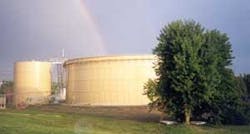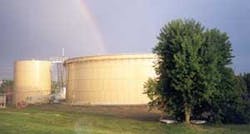Top 10 Things to Consider in a Storage Tank
by Mark Eklund, PE
If you're in the market for a liquid storage tank, don't be fooled into thinking all tanks are pretty much the same. Whether you plan to store potable water, wastewater, chemicals or other liquids, it's important to remember each material is unique and has its own specific requirements.
Before you begin shopping for tanks, be aware of a few key considerations to help ensure you get the best value and right storage vessel for the job.
Materials of Construction – The volume of material to be stored will help determine the construction materials for your tank. Exceptionally large volumes often require field welded steel and concrete tanks. Bolted and shop welded steel tanks will accommodate a wide range of volumes and materials.
Tank Size and Placement – Will the tank and its erection be limited by space requirements? For smaller spaces consider a tank of smaller diameter and taller height. Unlimited spaces will allow for a tank of wider diameter and shorter height. Both may accommodate a variety of materials and volumes.
Consider the Environment – Wind loads, seismic conditions and roof loads (such as snow loads) are important criteria for tank design.
Corrosion Resistant Coating – A storage tank's principal enemy is corrosion, and its only defense is its coating. Choose a technologically advanced coating such as Trico Bond™ that has been applied at the factory under environmentally controlled circumstances to ensure proper cure and even coat. Field applied coatings are subject to the environment during application and curing process.
Think About Expansion – Will your growing business demand expansion down the road? Field welded and concrete designs may not be expanded, while bolted tanks are expandable with simple hardware and gasket.
Think About Moving – Yes, it's possible to move some tanks. While field welded and concrete tanks are permanent, bolted designs may be taken apart and reassembled panel by panel.
The Safety Factor – Be sure the coating you choose is tested and certified for the liquid you're planning to store. Incorrect use of a tank could result in severe corrosion, premature failing of the coating, harm to the product or serious injury to personnel. Also, remember tanks and coatings to be used for drinking water storage must be NSF Standard 61 Certified.
Choose Your Features – Common features available for tanks today include vent(s), overflow, inlet, discharge nozzles, side and roof access manways, ladders, perimeter guardrails, and liquid level indicators. Ask your tank manufacturer about other specific needs you may have.
Compare Total Life Cycle Cost – Up front costs don't always reflect the total life cycle cost of a tank. Compare apples to apples when reviewing bids. Maintenance down the road (including recoating a tank) may be expensive. Typically, choosing a better coating up front will reflect lower maintenance costs down the road.
Choose an Experienced Vendor – To ensure your vendor is best for the job, ask lots of questions. How long has the company been manufacturing tanks? Do they offer a wastewater specialist? Are their coatings applied at the factory? Do they sell in your market, and in your country? Consider vendors with the ISO 9001 Quality Certification, and beware those that offer to manufacture to those standards without the actual certification.
There you have it.
About the Author: With over 30 year's experience, Mark Eklund, P.E., serves as a product manager for Columbian TecTank, a Kansas City-based firm specializing in design, fabrication, factory coating/thermally curing and erection of tanks for liquid and dry bulk storage, and with installations in 125 countries worldwide. Contact: 913-621-3700, [email protected] or www.columbiantectank.com
